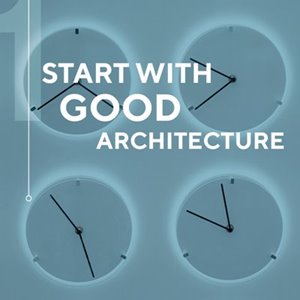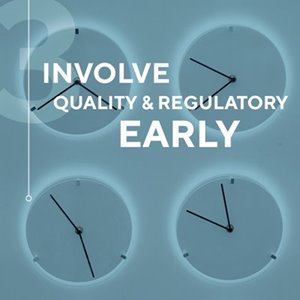4 Keys to Accelerating Your Medical Device Development Timeline

- 1. Improving medical device time to market starts with good architecture.
- 2. Plan for the variability of the real world from the start.
- 3. Involve key parties early in the medical device development process.
- 4. Choose the right medical device design and engineering partner.
- One final key: Believe in the process.
In the healthcare and life sciences industries, speed to market isn’t just a competitive advantage — it makes a tangible impact in people’s lives. The sooner you can bring a product or device to market, the sooner it can start helping the people who need it.
The desire to reduce time to market for medical devices — to get diagnostic and medical instruments into the hands of caregivers as quickly as possible — is what makes so many people passionate about their work in design and development. It’s certainly what drives our Plexus team. So, how can you accelerate innovation and reduce the time it takes to deliver these technologies to the people who count on them?
The COVID-19 pandemic demonstrated how quickly some manufacturers could ramp up development. It underscored one important truth: Developers of medical and life science devices must work smarter, not just faster, to avoid the surprises and costly, time-consuming changes that can slow a product launch.
Here are four effective strategies to accelerate your medical device development timeline:
- Start with good architecture
- Plan for the real world from the start
- Get quality and regulatory involved early
- Choose the right design and engineering partner
1. Improving medical device time to market starts with good architecture.

Nobody wants to hear the words “architectural change” when your product is nearing the transition to manufacturing. If you do, you’re in for delays and headaches.
That’s why it’s important to give your life science instrument or medical device design the attention it deserves. A good architecture design will lead a new product launch in the right direction from the start. And the more discovery you do at the beginning, before the design controls kick in, the faster you can move later. Allowing engineers to lay out a good architecture plan can mean more time up front. However, this process improves the likelihood that any modifications at the end of the design stage will be minor adjustments rather than costly, wholesale changes. You’ll dramatically reduce risk and ensure that you’re not spending your budget unnecessarily.
Moving to the next phase, consider the various approaches your design process could take. A more proven approach can be to first create and evaluate submodules of the design. This step can ensure that each piece performs as expected before being integrated into the system. Otherwise, you might find out later that you’ve overlooked some of the risks that each piece of the system can introduce.
Upfront work can help save you time and money. However, a key part of creating strong architecture is understanding the limitations of product design and that flexibility should be built into the process. Design revisions can happen. To stay ahead of this, engineers should take the time to answer two questions:
- What aspects of the design must be flawless?
- What design issues can be managed once the product is in the field?
The key takeaway: Rather than jumping straight into design, afford yourself the few weeks — even a few months — to understand user needs (more on this in #2), burn down risk and establish the right architecture.
2. Plan for the variability of the real world from the start.

Often, getting a product to work in the lab is the easy part. What’s far more difficult is making sure the product can handle all the variability that will be encountered through its journey from manufacturing to the point of care.
Because the manufacturing process can be highly complex, designing for manufacturability and high-level assembly reduces risks during the ramp up to production. Don’t just prove that the components of the device work with a one-time test on the bench. Instead, stress test each component to make sure it will hold up in the manufacturing process.
In addition, you don’t want to wait until a product is in the field to discover that it’s not properly designed for the behaviors and practices of the people who use it. This is where a user-centered design (UCD) approach pays off in spades. UCD addresses the user experience, ergonomics and human factors to develop a design strategy that aligns the product with the skills and needs of those who will actually use the device in their environment. At Plexus, our uniquely integrated UCD team provides a critical link between the user’s needs, the product development team’s expectations and the realities of engineering a product that ties them all together. This intersection of research, strategy and design is an important part of the process to build a concept into a successful, real-world product that serves your purposes and delights your end users.
3. Involve key parties early in the medical device development process.

Sometimes, quality and regulatory requirements are treated as little more than boxes to be checked in the design process. Complex regulations may be given to engineers as a set of requirements. Or quality and regulatory engineers may only be brought in on the back end of the design process for review.
This path can introduce risk into your design process, because discovering a quality or regulatory issue with a product late in the design stage can result in costly, extensive design changes. Quality and regulatory engineers should be core members, not just auditors, of the design process. Their expertise should be used in both designing a product and reviewing it. This integration of quality with design can be one of the most effective ways to avoid delays late in the game.
Regulatory personnel who track the evolving regulatory landscape can also provide updates about changes coming down the pipeline. This process can help you make critical decisions about your product’s compliance and keep designs on track to meet requirements from the start.
Quality and regulatory engineers should be core members — not just auditors — of the design process.
4. Choose the right medical device design and engineering partner.

Many companies turn to a design partner to help launch new devices. Choose your partner wisely! The right design and development partner can do more than supplement your team — they can help accelerate time to market for medical devices and reduce the costly surprises that sometimes delay your launch.
So, what should you look for in a partner?
For starters, the design team should be both highly capable and actively engaged. They should not only align with your strategy but also actively seek out ways to support that strategy.
If speed to market is critical to your launch, for instance, how will your partner’s design team support that goal? Will they focus their efforts on areas like developing a minimum viable product or product defeaturing to help simplify the design? Will they identify aspects of the product that should be bought instead of designed to help save precious design time?
Communication is also critical. Ideally, your partner will be good about communicating changes and the reasoning behind them. They should also be willing to provide feedback on requirements and be eager to offer up alternative solutions. And they should seek frequent checkpoints and update dashboards based on your feedback or evolving project priorities. At Plexus, we’ve put tools in place to specifically track customer milestones and keep progress visible to both project teams and senior management.
Finally, seek out a partner who can help you get in front of risks during the design phase. This can be invaluable. By using a technology-readiness assessment process, for instance, a partner can reveal risks in the design, supply chain and manufacturing of a new product. This process can help you address those risks early, before they evolve into costly problems.
One final key: Believe in the process.
More time spent on your architecture design, more people involved early in the design process and more communications with engineering teams can seem like a recipe for a longer, more drawn-out development process. The fact is that these are critical steps in actually speeding up the process. They pay off by mitigating many of the things that can go wrong during complex design and development — but if you want to reap the benefits, you do need to believe in and commit to the process.
At Plexus, we believe in and adopt these practices because we’ve seen them work in the countless healthcare and life science products we’ve helped our customers bring to market. And we believe they’re the best way to get your products where they can do the most good, quickly.
If you’d like to learn more, or if you’re looking for help accelerating your life science or medical device design and development efforts, get in touch with our team to start a conversation.
- 1. Improving medical device time to market starts with good architecture.
- 2. Plan for the variability of the real world from the start.
- 3. Involve key parties early in the medical device development process.
- 4. Choose the right medical device design and engineering partner.
- One final key: Believe in the process.


